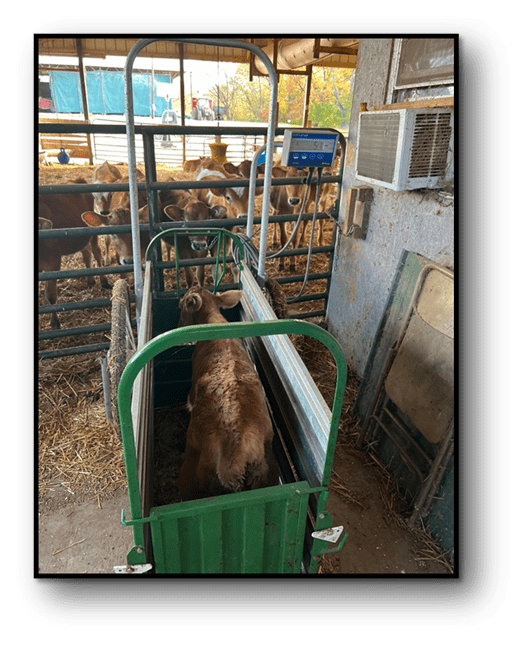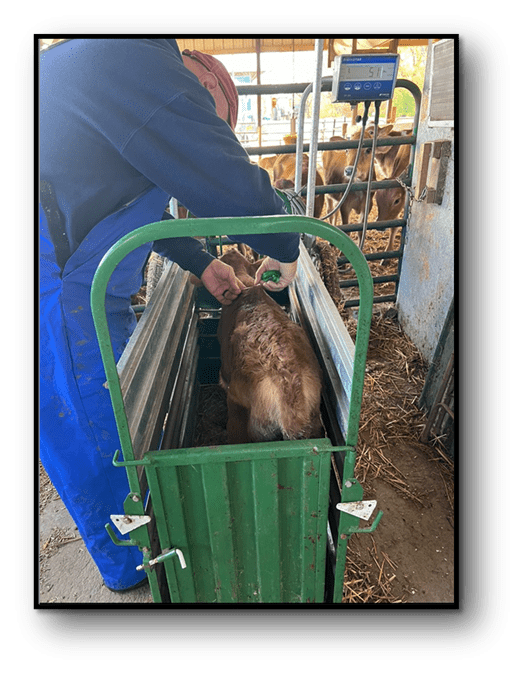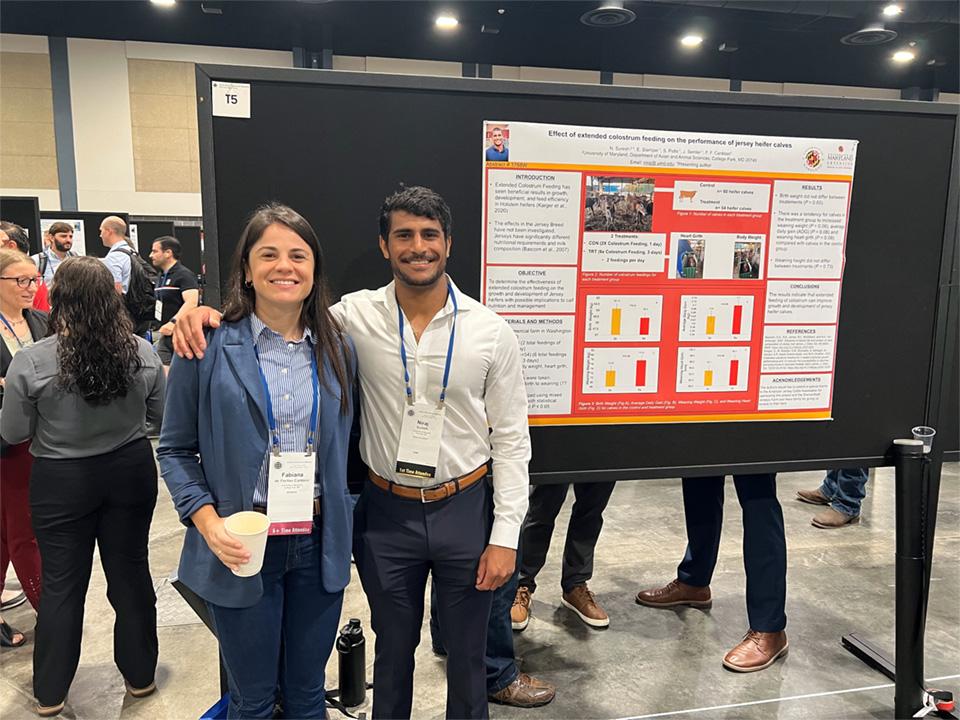
Effect of Extended Colostrum Feeding on the Performance of Jersey Heifers
Niraj Suresh, Animal & Avian Sciences, University of Maryland and Fabiana Cardoso, Animal & Avian Sciences, University of Maryland
This study aimed to investigate how extended colostrum feeding in Jersey heifer calves can affect their growth and development. Research has shown beneficial results in Holsteins, but research has not been done on the Jersey breed. Colostrum is the first milk any mammalian mother gives. It is rich in antibodies known as immunoglobulins. It is essential for any newborn to intake colostrum to receive what is known as the passive transfer of immunity, as a newborn’s immune system is underdeveloped and has no exposure to the outside world. Colostrum is also higher in protein and fat compared with regular milk. After about 24 hours, the composition of the colostrum will begin to transition into regular milk, so it is essential that the newborn nurses and consumes colostrum as soon as possible.
The experiment was conducted at the Shenandoah Jerseys farm in Boonsboro, Maryland. We would like to thank the Hess family for allowing us to use their herd for this study.
- After the calves were born, they were placed in a solitary pen.
- Control group: 2 total colostrum feedings, 1 day
- Treatment Group: 6 total colostrum feedings, 3 days (2X day)
Focal point
- The University of Maryland Department of Animal and Avian Sciences along with the University of Maryland Extension Service have been collaborating on applied dairy research.
- One project in collaboration with the Washington County Extension Service involved an experiment investigating the effects of extended colostrum feeding on the growth and development of Jersey heifer calves.
- Another project aims to assess the knowledge and understanding dairy farmers have on mycotoxins and microorganisms (specifically clostridium) on contamination of their TMR. This project involves a survey, visiting farms for feed samples to test for contamination, and supplying farmers with educational materials.
After their colostrum feeding period was finished, they were all moved to a group pen with a free choice milk feeder that fed milk replacer until they were weaned at 77 days. Calves from both groups were housed in the same group pen, the only difference was during the colostrum period.
Data was collected for body weight, heart girth, and hip height.
- Heart girth is a measurement of the circumference of the animal's body. A tape measure is wrapped around the animal right behind the shoulder blades.
- Hip height was measured using a ruler with a balance beam placed at the rump of the cow.



The data found that there was a tendency towards significance for an increase in weaning weight, average daily gain, and heart girth for the treatment group compared to the control group. Hip height did not differ significantly between groups. Birth weight did not differ significantly between groups indicating that the treatment group did not have an advantage at birth. These results indicate that extended colostrum feeding for jersey calves leads to accelerated weight gain and fuller bodied calves at weaning.
The calves will now be tracked all the way till their first lactation to assess differences in reproduction and lactation between treatment and control groups. This will be the deciding factor on whether or not it is economically feasible to have extended colostrum feeding in Jersey calves.
These results were presented as a poster at the American Dairy Science Association (ADSA) Annual Meeting by Niraj Suresh, a master's student working under Dr. Fabiana Cardoso. Other authors include Jeff Semler; a principle extension agent in Washington County, Sarah Potts; a former beef and dairy extension specialist, and Emily Stamper. The ADSA annual meeting is internationally recognized as the premier dairy science conference. The poster received positive feedback from various respected scientists from several institutions across the globe.
This article appears on September 2024, in Volume 5, Issue 2, of the Maryland Milk Moos newsletter.
Maryland Milk Moo's, September 2024, Vol. 5, Issue 2
Maryland Milk Moos is a quarterly newsletter published by the University of Maryland Extension that focuses on dairy topics related to Nutrition and Production, Herd Management, and Forage Production.
Want to subscribe?
Email dairyextension@gmail.com. In the body of the text, type subscribe, and include your first and last name and email address.
 English
English العربية
العربية Български
Български 简体中文
简体中文 繁體中文
繁體中文 Hrvatski
Hrvatski Čeština
Čeština Dansk
Dansk Nederlands
Nederlands Suomi
Suomi Français
Français Deutsch
Deutsch Ελληνικά
Ελληνικά हिन्दी
हिन्दी Italiano
Italiano 日本語
日本語 한국어
한국어 Norsk bokmål
Norsk bokmål Polski
Polski Português
Português Română
Română Русский
Русский Español
Español Svenska
Svenska Català
Català Filipino
Filipino עִבְרִית
עִבְרִית Bahasa Indonesia
Bahasa Indonesia Latviešu valoda
Latviešu valoda Lietuvių kalba
Lietuvių kalba Српски језик
Српски језик Slovenčina
Slovenčina Slovenščina
Slovenščina Українська
Українська Tiếng Việt
Tiếng Việt Shqip
Shqip Eesti
Eesti Galego
Galego Magyar
Magyar Maltese
Maltese ไทย
ไทย Türkçe
Türkçe فارسی
فارسی Afrikaans
Afrikaans Bahasa Melayu
Bahasa Melayu Kiswahili
Kiswahili Gaeilge
Gaeilge Cymraeg
Cymraeg Беларуская мова
Беларуская мова Íslenska
Íslenska Македонски јазик
Македонски јазик יידיש
יידיש Հայերեն
Հայերեն Azərbaycan dili
Azərbaycan dili Euskara
Euskara ქართული
ქართული Kreyol ayisyen
Kreyol ayisyen اردو
اردو বাংলা
বাংলা Bosanski
Bosanski Cebuano
Cebuano Esperanto
Esperanto ગુજરાતી
ગુજરાતી Harshen Hausa
Harshen Hausa Hmong
Hmong Igbo
Igbo Basa Jawa
Basa Jawa ಕನ್ನಡ
ಕನ್ನಡ ភាសាខ្មែរ
ភាសាខ្មែរ ພາສາລາວ
ພາສາລາວ Latin
Latin Te Reo Māori
Te Reo Māori मराठी
मराठी Монгол
Монгол नेपाली
नेपाली ਪੰਜਾਬੀ
ਪੰਜਾਬੀ Afsoomaali
Afsoomaali தமிழ்
தமிழ் తెలుగు
తెలుగు Yorùbá
Yorùbá Zulu
Zulu ဗမာစာ
ဗမာစာ Chichewa
Chichewa Қазақ тілі
Қазақ тілі Malagasy
Malagasy മലയാളം
മലയാളം සිංහල
සිංහල Sesotho
Sesotho Basa Sunda
Basa Sunda Тоҷикӣ
Тоҷикӣ O‘zbekcha
O‘zbekcha አማርኛ
አማርኛ Corsu
Corsu Ōlelo Hawaiʻi
Ōlelo Hawaiʻi كوردی
كوردی Кыргызча
Кыргызча Lëtzebuergesch
Lëtzebuergesch پښتو
پښتو Samoan
Samoan Gàidhlig
Gàidhlig Shona
Shona سنڌي
سنڌي Frysk
Frysk isiXhosa
isiXhosa